Effect of Varying Nitrogen and Micronutrient Fertilization on Yield Quantity and Quality of Sunflower (Helianthus annuus L.) Achenes
Abstract
:1. Introduction
2. Materials and Methods
2.1. Field Conditions
- A—60 kg N ha−1
- B—90 kg N ha−1
- C—60 kg N ha−1 and foliar fertilization
- D—90 kg N ha−1 and foliar fertilization
- E—60 kg N ha−1 and double foliar fertilization
- F—90 kg N ha−1 and double foliar fertilization
2.2. Chemical Composition
2.3. Economic Analysis
2.4. Statistical Analyses
3. Results
3.1. Weather Conditions
3.2. Field and Biometric Measurements
3.3. Yield of Achenes
3.4. Chemical Composition
3.5. Fat and Protein Yield
3.6. Economic Results
4. Discussion
5. Conclusions
Funding
Data Availability Statement
Conflicts of Interest
References
- Ailwar, B.P.; Ghodke, M.K.; Tathe, R.G. Heterosis for yield and yield contributing traits in sunflower (Helianthus annuus L.). Electron. J. Plant Breed. 2020, 11, 950–953. [Google Scholar] [CrossRef]
- Lakshman, S.S.; Chakrabarty, N.R.; Kole, P.C. Economic heterosis in sunflower (Helianthus annuus L.): Seed yield and yield attributing traits in newly developed hybrids. Electron. J. Plant Breed. 2020, 11, 461–468. [Google Scholar] [CrossRef]
- Tangyu, M.; Fritz, M.; Ye, L.; Börner, R.A.; Morin-Rivron, D.; Campos-Gimėnez, E.; Bolten, C.J.; Bogicevi, B.; Wittmann, C. Co-cultures of Propionibacterium freudenreichii and Bacillus amyloliquefaciens cooperatively upgrade sunflower seed milk to high levels of vitamin B12 and multiple co-benefits. Microb. Cell Fact. 2022, 21, 48. [Google Scholar] [CrossRef] [PubMed]
- Dilipkumar, P. Chapter 130-Sunflower (Helianthus annuus L.) seeds in health and nutrition. In Patel, Nuts and Seeds in Health and Disease Prevention; Victor, R., Preedy, R.R.W., Vinood, B., Eds.; Academic Press: Cambridge, MA, USA, 2011; pp. 1097–1105. [Google Scholar] [CrossRef]
- Zeinalzadeh-Tabrizi, H.; Hosseinpour, A.; Ghaffari, M.; Haliloglu, K. Genetic structure and marker-trait associations in parental lines of sunflower (Helianthus annuus L.). Iran. J. Plant Physiol. 2022, 12, 3955–3971. [Google Scholar] [CrossRef]
- Hlisnikovský, L.; Kunzová, E.; Hejcman, M.; Škarpa, P.; Menšík, L. Effect of nitrogen, boron, zinc and molybdenum application on yield of sunflower (Helianthus annuus L.) on greyic phaeozem in the Czech Republic. Helia 2016, 39, 91–111. [Google Scholar] [CrossRef]
- Sher, A.; Suleman, M.; Sattar, A.; Qayyum, A.; Ijaz, M.; Sami-Ul Allah, A.-Y.R.; Al-Hashimi, A.; Elshikh, M.S. Achene yield and oil quality of diverse sunflower (Helianthus annuus L.) hybrids are affected by different irrigation sources. J. King Saud Univ. Sci. 2022, 34, 102016. [Google Scholar] [CrossRef]
- Li, Z.; Fontanier, C.; Dunn, B.L. Physiological response of potted sunflower (Helianthus annuus L.) to precision irrigation and fertilizer. Sci. Hortic. 2020, 270, 109417. [Google Scholar] [CrossRef]
- Watanabe, T.; Okada, R.; Urayama, M. Differences in ionomic responses to nutrient deficiencies among plant species under field conditions. J. Plant Nutr. 2022, 45, 1493–1503. [Google Scholar] [CrossRef]
- Hammad, H.; Tahir, M.A.; Sabah, N.U.; Sarwar, G.; Aftab, M.; Manzoor, M.Z.; Riaz, A.; Niaz, A.; Arif, M. Phosphorus utilization efficiency by sunflower (Helianthus annuus L.) from sparingly soluble P source under P deficient environment. Pak. J. Agric. Res. 2021, 34, 294–299. [Google Scholar] [CrossRef]
- Kováčik, P.; Kozánek, M.; Takáč, P.; Galliková, M.; Varga, L. The effect of pig manure fermented by larvae of house flies on the yield parameters of sunflowers (Helianthus annus L.). Acta Univ. Agric. Silvic. Mendel. Brun. 2010, 58, 147–154. [Google Scholar] [CrossRef]
- Mokgolo, M.J.; Mzezewa, J.; Odhiambo, J.J.O. Poultry and cattle manure effects on sunflower performance, grain yield and selected soil properties in Limpopo Province, South Africa. S. Afr. J. Sci. 2019, 115, 6. [Google Scholar] [CrossRef]
- Sharma, K.L.; Neelaveni, K.; Katyal, J.C.; Srinivasa Raju, A.; Srinivas, K.; Kusuma Grace, J. Effect of combined use of organic and inorganic sources of nutrients ons yield, soil fertility, and overall soil quality in rainfed alfisol. Commun. Soil Sci. Plant Anal. 2008, 39, 1791–1831. [Google Scholar] [CrossRef]
- Soleymani, F.; Ahmadvand, G.; Safari Sanjani, A.A. The effect of chemical, biological and organic nutritional treatments on sunflowers yield and yield components under the influence of water deficit stress. J. Agroecol. 2016, 8, 107–119. [Google Scholar] [CrossRef]
- Oshundiya, F.O.; Olowe, V.I.O.; Sowemimo, F.A.; Odedina, J.N. Seed yield and quality of sunflower (Helianthus annuus L.) as influenced by staggered sowing and organic fertilizer application in the humid tropics. Helia 2014, 37, 237–255. [Google Scholar] [CrossRef]
- Sefaoglu, F.; Ozturk, H.; Ozturk, E.; Sezek, M.; Toktay, Z.; Polat, T. Effect of organic and inorganic fertilizers, or their combinations on yield and quality components of oil seed sunflower in a semi-arid environment. Turk. J. Field Crops 2021, 26, 88–95. [Google Scholar] [CrossRef]
- Rocha, J.G.; Alves, L.S.; Tavares, O.C.H.; Stark, E.M.L.M.; Fernandes, M.S.; Castro, R.N.; Santos, A.M.; Souza, S.R. Metabolic characterization and oil profile of sunflower cultivars cultivated with increasing nitrogen doses. Biosci. J. 2020, 36, 266–279. [Google Scholar] [CrossRef]
- Oyinlola, E.Y.; Ogunwole, J.O.; Amapu, I.Y. Response of sunflower (Helianthus annuus L.) to nitrogen application in a savanna alfisol. Helia 2010, 33, 115–126. [Google Scholar] [CrossRef]
- Ahmad, M.I.; Ali, A.; He, L.; Latif, A.; Abbas, A.; Ahmad, J.; Ahmad, M.Z.; Asghar, W.; Bilal, M.; Mahmood, M.T. Nitrogen effects on sunflower growth: A review. Int. J. Biosci. 2018, 12, 91–101. [Google Scholar]
- Sincik, M.; Goksoy, A.T.; Dogan, R. Responses of sunflower (Helianthus annuus L.) to irrigationand nitrogen fertilization rates. Zemdirb.-Agric. 2013, 100, 151–158. [Google Scholar] [CrossRef]
- Kandil, A.A.; Sharief, A.E.; Odam, A.M.A. Response of some sunflower hybrids (Helianthus annuus L.) to different nitrogen fertilizer rates and plant densities. Int. J. Environ. Agric. Biotechnol. 2017, 2, 2978–2994. [Google Scholar] [CrossRef]
- Zeng, W.Z.; Xu, C.; Wu, J.W.; Huang, J.S.; Zhao, Q.; Wu, M.S. Impacts of salinity and nitrogen on the photosynthetic rate and growth of sunflowers (Helianthus annuus L.). Pedosphere 2014, 24, 635–644. [Google Scholar] [CrossRef]
- Zeng, W.; Xu, C.; Huang, J.; Wu, J.; Ma, T. Emergence rate, yield, and nitrogen-Use efficiency of sunflowers (Helianthus annuus) vary with soil salinity and amount of nitrogen applied. Commun. Soil Sci. Plant Anal. 2015, 46, 1006–1023. [Google Scholar] [CrossRef]
- Ozturk, E.; Polat, T.; Sezek, M. The effect of sowing date and nitrogen fertilizer form on growth, yield and yield components in sunflower. Turk. J. Field Crops 2017, 22, 143–151. [Google Scholar] [CrossRef]
- Souza, A.R.E.; Souza, Ê.G.F.; Tartaglia, F.L.; Santos, A.P.; Barros Júnior, A.P.; Silveira, L.M.; Bezerra Neto, F.; Santos, M.G. Economic indicators of nitrogen fertilization in sunflower cultivars. Biosci. J. 2020, 36, 1938–1950. [Google Scholar] [CrossRef]
- Eltarabily, M.G.; Burke, J.M.; Bali, K.M. Effect of deficit irrigation on nitrogen uptake of sunflower in the low desert region of California. Water 2019, 11, 2340. [Google Scholar] [CrossRef]
- Soleymani, A. Light response of sunflower and canola as affected by plant density, plant genotype and N fertilization. J. Photochem. Photobiol. B Biol. 2017, 173, 580–588. [Google Scholar] [CrossRef] [PubMed]
- Qadeer, A.; Tahir, M.M.; Abbasi, M.K.; Ali, A.; Rasheed, A. Morphological and phenological responses of sunflower to nitrogen fertilization and plant growth promoting rhizobacteria under rainfed conditions in Pakistan: Morpho-phenological responses of sunflower to plant growth promoting rhizobacteria and nitrogen. Proc. Pak. Acad. Sci. B Life Environ. Sci. 2021, 56, 41–48. Available online: https://ppaspk.org/index.php/PPAS-B/article/view/184 (accessed on 28 July 2022).
- Travlos, I.; Papastylianou, P.; Alexos, A.; Kanatas, P.; Bilalis, D.; Tsekoura, A.; Kakabouki, I.; Cheimona, N. Changes of weed flora due to nitrogen addition in sunflower. Not. Bot. Horti Agrobot. Cluj-Napoca 2019, 47, 1337–1339. [Google Scholar] [CrossRef]
- Hajduk, E.; Gąsior, J.; Właśniewski, S.; Nazarkiewicz, M.; Kaniuczak, J. Influence of liming and mineral fertilization on the yield and boron content of potato tubers (Solanum tuberosum L.) and green mass of fodder sunflower (Helianthus annuus L.) cultivated in loess soil. J. Elem. 2017, 22, 411–426. [Google Scholar] [CrossRef]
- Alves, L.S.; Stark, E.M.L.M.; Zonta, E.; Fernandes, M.S.; Santos, A.M.; Souza, S.R. Different nitrogen and boron levels influence the grain production and oil content of a sunflower cultivar. Acta Sci. Agron. 2017, 39, 59–66. [Google Scholar] [CrossRef]
- Alipatra, A.; Banerjee, H.; Bhattacharyya, K.; Bandopadhyay, P.; Ray, K. Yield and quality of hybrid sunflower (Helianthus annuus) as affected by irrigation and fertilization. Indian J. Agric. Sci. 2019, 89, 1419–1424. [Google Scholar]
- Gomes, K.R.; Viana, T.V.; Sousa, A.; Costa, G.G.; Azevedo, F.R.B. Irrigation and organic and mineral fertilization in sunflower crop. Comun. Sci. 2018, 8, 356–366. [Google Scholar] [CrossRef]
- Milev, G. Effect of foliar fertilization on sunflower (Helianhtus annuus L.). Agric. Sci. Technol. 2015, 7, 324–327. [Google Scholar]
- El-Din Mekki, B. Effect of boron foliar application on yield and quality of some sunflower (Helianthus annuus L.) cultivars. J. Agric. Sci. Technol. 2015, 5, 309–316. [Google Scholar] [CrossRef]
- Shehzad, M.A.; Maqsood, M. Integrated nitrogen and boron fertilization improves the productivity and oil quality of sunflower grown in a calcareous soil. Turk. J. Field Crops 2015, 20, 213–222. [Google Scholar] [CrossRef]
- Shehzad, M.A.; Maqsood, M.; Wajid, S.A.; Anwar-ul-Haq, M. Dry matter partitioning and mineral constitution response of sunflower (Helianthus annuus) to integrated nitrogen and boron nutrition in calcareous soils. Int. J. Agric. Biol. 2016, 18, 257–265. [Google Scholar] [CrossRef]
- Bozca, F.D.; Leblebici, S. Interactive effect of boric acid and temperature stress on phenological characteristics and antioxidant system in Helianthus annuus L. S. Afr. J. Bot. 2022, 147, 391–399. [Google Scholar] [CrossRef]
- Al-Amery, M.M.; Hamza, J.H.; Fuller, M.P. Effect of boron foliar application on reproductive growth of sunflower (Helianthus annuus L.). Int. J. Agron. 2011, 230712, 1–5. [Google Scholar] [CrossRef]
- Khalid, D.; Saad, D.; Kacem, M.; Ezzahra, N.F.; Fouad, A.; Abdelhadi, A.H. Sunflower response to Boron supply when grown in a silty clay soil. J. Saudi Soc. Agric. Sci. 2020, 19, 81–86. [Google Scholar] [CrossRef]
- Asad, A.; Blamey, F.P.C.; Edwards, D.G. Effects of boron foliar applications on vegetative and reproductive growth of sunflower. Ann. Bot. 2003, 92, 565–570. [Google Scholar] [CrossRef]
- Ekmekçi, Y.; Erdal, Ş.Ç.; Nalçaiyi, A.S.B.; Çiçek, N. Acquisition of boron tolerance by salt pretreatment in two sunflower cultivars. Turk. J. Bot. 2020, 44, 4. [Google Scholar] [CrossRef]
- Fernández, V.; Brown, P.H. From plant surface to plant metabolism: The uncertain fate of foliar-applied nutrients. Front. Plant Sci. 2013, 4, 289. [Google Scholar] [CrossRef] [PubMed]
- Brown, P.H.; Shelp, B. Boron mobility in plants. Plant Soil 1997, 193, 85–101. [Google Scholar] [CrossRef]
- Baraich, A.A.K.; Gandahi, A.W.; Tunio, S.; Chachar, Q. Influence of micronutrients and their method of application on yield and yield components of sunflower. Pak. J. Bot. 2016, 48, 1925–1932. [Google Scholar]
- Bhattacharyya, K.; Mandal, J.; Banerjee, H.; Alipatra, A.; Ray, K.; Phonglosa, A. Boron fertilization in sunflower (Helianthus annuus L.) in an Inceptisol of West Bengal, India. Commun. Soil Sci. Plant Anal. 2015, 46, 528–544. [Google Scholar] [CrossRef]
- Andrade, A.F.; Vicosi, K.A.; Bueno, A.M.; Flores, R.A.; Santos, C.L.R.; Santos, G.G.; Mesquita, M. Nutritional and biomass aspects of Helianthus annuus according to boron application in the soil. Aust. J. Crop Sci. 2021, 15, 899–908. [Google Scholar] [CrossRef]
- Singh, D.B.; Sharma, P.K.; Sanjula, S. Oil yield and fatty acid profile of staggered sown spring sunflower (Helianthus annuus L.) in response to foliar application of boron and tiba. Appl. Biol. Res. 2017, 19, 156–163. [Google Scholar] [CrossRef]
- Khan, I.; Ahmad Anjum, S.; Khan Qardri, R.W.; Ali, M.; Umer Chattha, M.; Asif, M. Boosting achene yield and yield related traits of sunflower hybrids through boron application strategies. Am. J. Plant Sci. 2015, 6, 1752–1759. [Google Scholar] [CrossRef]
- Pattanayak, S.; Behera, A.K.; Das, P.; Nayak, M.R.; Jena, S.N.; Behera, S. Performance of summer sunflower (Helianthus annuus L.) hybrids under different nutrient management practices in coastal Odisha. J. Appl. Nat. Sci. 2017, 9, 435–440. [Google Scholar] [CrossRef]
- Kumar, A.; Tripti, M.M.; Bruno, L.B.; Rajkumar, M. Synergistic effect of ACC deaminase producing Pseudomonas sp. TR15a and siderophore producing Bacillus aerophilus TR15c for enhanced growth and copper accumulation in Helianthus annuus L. Chemosphere 2021, 276, 130038. [Google Scholar] [CrossRef]
- Hajduk, E.; Nazarkiewicz, M.; Gąsior, J.; Właśniewski, S.; Kaniuczak, J. Effect of fertilization on the Mo content in potato tubers (Solanum tuberosum L) and sunflower biomass (Helianthus annuus L.) cultivated on a Luvisol formed from loess. J. Elem. 2020, 25, 1115–1126. [Google Scholar] [CrossRef]
- Steiner, F.; Zoz, T. Foliar application of molybdenum improves nitrogen uptake and yield of sunflower. Afr. J. Agric. Res. 2015, 10, 1923–1928. [Google Scholar] [CrossRef]
- Škarpa, P.; Kunzová, E.; Zukalová, H. Foliar fertilization with molybdenum in sunflower (Helianthus annuus L.). Plant Soil Environ. 2013, 59, 156–161. [Google Scholar] [CrossRef]
- Li, C.; Wang, L.; Wu, J.; Blamey, F.P.C.; Wang, N.; Chen, Y.; Ye, Y.; Wang, L.; Paterson, D.J.; Read, T.L.; et al. Translocation of foliar absorbed Zn in sunflower (Helianthus annuus) leaves. Front. Plant Sci. 2022, 13, 757048. [Google Scholar] [CrossRef] [PubMed]
- Kandhro, M.N.; Abbasi, Z.A.; Soomro, A.A.; Leghari, N.; Keerio, M.I.; Shah, A.N.; Jamro, G.M.; Mangrio, N.; Tunio, S.P. Evaluation of irrigation frequencies and seed priming with plant nutrients on growth and yield of sunflower (Helianthus annuus L.) genotypes. Pak. J. Agric. Res. 2021, 34, 58–69. [Google Scholar] [CrossRef]
- Li, C.; Wang, P.; Menzies, N.W.; Lombi, E.; Kopittke, P.M. Effects of changes in leaf properties mediated by methyl jasmonate (MeJA) on foliar absorption of Zn, Mn and Fe. Ann. Bot. 2017, 120, 405–415. [Google Scholar] [CrossRef]
- Li, C.; Wang, P.; Lombi, E.; Wu, J.; Blamey, F.P.C.; Fernández, V.; Howard, D.L.; Menzies, N.W.; Kopittke, P.M. Absorption of foliar applied Zn is decreased in Zn deficient sunflower (Helianthus annuus) due to changes in leaf properties. Plant Soil 2018, 433, 309–322. [Google Scholar] [CrossRef]
- IUSS Working Group WRB. International Soil Classification System for Naming Soils and Creating Legends for Soil Maps. In Word Reference Base for Soil Resources 2014, Update 2015; Word Soil Resources Reports No. 106; FAO: Rome, Italy, 2015; p. 192. [Google Scholar]
- Fatahi, A.; Safarian Zengir, V.; Sobhani, B.; Kianian, M.K.; Ghahremani, A. Assessment and zoning of suitable climate for economic development of cultivation of Sunflower (Helianthus annuus) garden crop (Ardabil Province, Iran). Eur. J. Hortic. Sci. 2022, 87, 1–12. [Google Scholar] [CrossRef]
- Černý, I.; Veverková, A.; Kovár, M.; Mátyás, M. The variability of sunflower (Helianthus annuus L.) yield and quality influenced by the weather conditions. Acta Univ. Agric. Silvic. Mendel. Brun. 2013, 61, 595–600. [Google Scholar] [CrossRef]
- Ahmad, H.M.; Wang, X.; Ur-Rahman, M.; Fiaz, S.; Azeem, F.; Shaheen, T. Morphological and physiological response of Helianthus annuus L. to drought stress and correlation of wax contents for drought tolerance traits. Arab. J. Sci. Eng. 2022, 47, 6747–6761. [Google Scholar] [CrossRef]
- Mahpara, S.; Shahnawaz, M.; Rehman, K.; Qaisarani, T.B.; Ahmad, R.; Khan, F.U. Nitrogen fertilization induced drought tolerance in sunflower: A review. Pure Appl. Biol. 2019, 8, 1675–1683. [Google Scholar] [CrossRef]
- Neves, J.M.G.; Aquino, L.A.; Berger, P.G.; Neves, J.C.L.; Rocha, G.C.; Barbosa, E.A. Silicon and boron mitigate the effects of water deficit on sunflower. Rev. Bras. Eng. Agríc. Ambient. 2019, 23, 175–182. [Google Scholar] [CrossRef]
- Lakshman, J.S.S.; Ghotke, M.K.; Kar, J. Estimation of economic heterosis for seed and oil yield in sunflower (Helianthus annuus L.) hybrids for coastal saline belt. Electron. J. Plant Breed. 2021, 12, 335–341. [Google Scholar] [CrossRef]
- Ravikumar, C.; Karthikeyan, A.; Senthilvalavan, P.; Manivannan, R. Effect of sulphur, zinc and boron on the growth and yield enhancement of sunflower (Helianthus annuus L.). J. Appl. Nat. Sci. 2021, 13, 295–300. [Google Scholar] [CrossRef]
- Dastorani, M.; Albaji, M.; Nasab, S.B. Crop response and water productivity of sunflower (Helianthus annuus L.) drip-irrigated with magnetically treated and non-magnetically treated water with variable salinity. Water SA 2022, 48, 90–96. [Google Scholar] [CrossRef]
- Takács, P.; Kovács, Z.; Száz, D.; Egri, Á.; Bernáth, B.; Slíz-Balogh, J.; Nagy-Czirok, M.; Lengyel, Z.; Horváth, G. Mature sunflower inflorescences face geographical east to maximize absorbed light energy: Orientation of Helianthus annuus heads studied by drone photography. Front. Plant Sci. 2022, 13, 842560. [Google Scholar] [CrossRef]
- Al Myali, A.A.H.; Alnuaimi, J.J.J.; Hussain, M.H. Effect of bio-fertilizer, organic manure, nano zinc oxid and interaction on the growth parameters for sunflower plant Helianthus annuus L. J. Kerbala Agric. Sci. 2020, 7, 1–19. [Google Scholar]
- Joergensen, R.G.; Toncea, I.; Boner, M.; Heß, J. Evaluation of organic sunflower fertilization using δ15N values. Org. Agric. 2019, 9, 365–372. [Google Scholar] [CrossRef]
- Lindström, L.I.; Franchini, M.C.; Nolasco, S.M. Sunflower fruit hullability and structure as affected by genotype, environment and canopy shading. Ann. Appl. Biol. 2022, 180, 338–347. [Google Scholar] [CrossRef]
- Göçmen, E.; Salbaş, B.; Erdem, T. Effects of different irrigation regimes on seed yield, oil content and fatty acid quality of the sunflower in Thrace region. Turkey. J. Elem. 2022, 27, 597–609. [Google Scholar] [CrossRef]
- Mehmood, A.; Saleem, M.F.; Tahir, M.; Sarwar, M.A.; Abbas, T.; Zohaib, A.; Abbas, H.T. Sunflower (Helianthus annuus L.) growth, yield and oil quality response to combined application of nitrogen and boron. Pak. J. Agric. Res. 2018, 31, 86–97. [Google Scholar] [CrossRef]
- Carvalho, L.M.; Carvalho, H.W.L.; Carvalho, C.G.P. Yield and photosynthetic attributes of sunflower cultivars grown under supplemental irrigation in the semiarid region of the Brazilian Northeast. Pesqui. Agropecu. Bras. 2020, 55, e01715. [Google Scholar] [CrossRef]
- Ribeiro, M.F.S.; Raiher, A.P. Economic performance of sunflower in family farming systems of southeastern Paraná, southern Brazil. Ciênc. Rural 2013, 43, 786–791. [Google Scholar] [CrossRef] [Green Version]
- Sheoran, P.; Sardana, V.; Chander, S.; Kumar, A.; Meena, M.D.; Bali, A.; Sharma, P. Sulphur, boron and zinc nutrition to improve productivity, profitability and oil quality in sunflower (Helianthus annuus). Indian J. Agric. Sci. 2018, 88, 1746–1754. [Google Scholar]
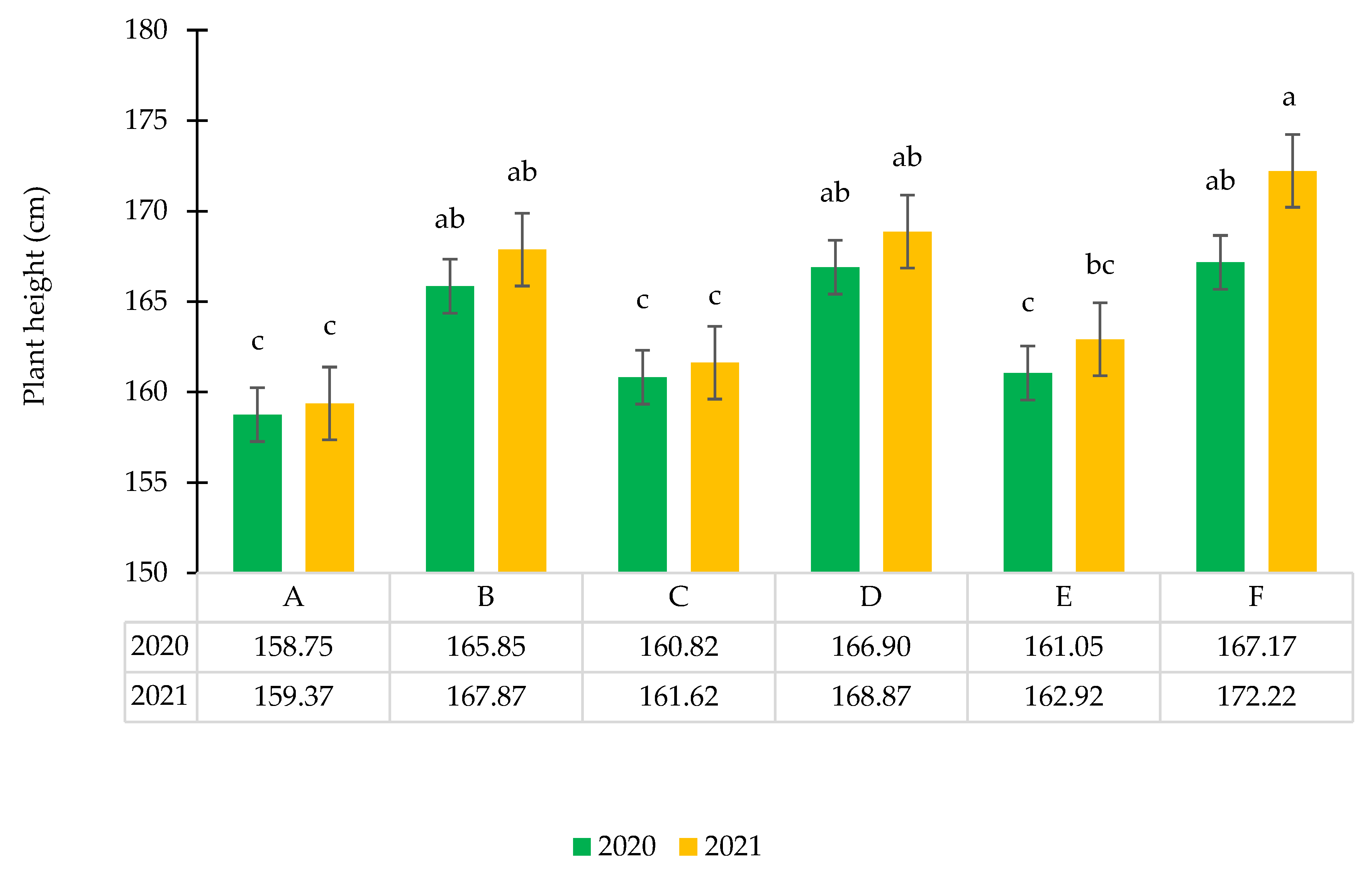
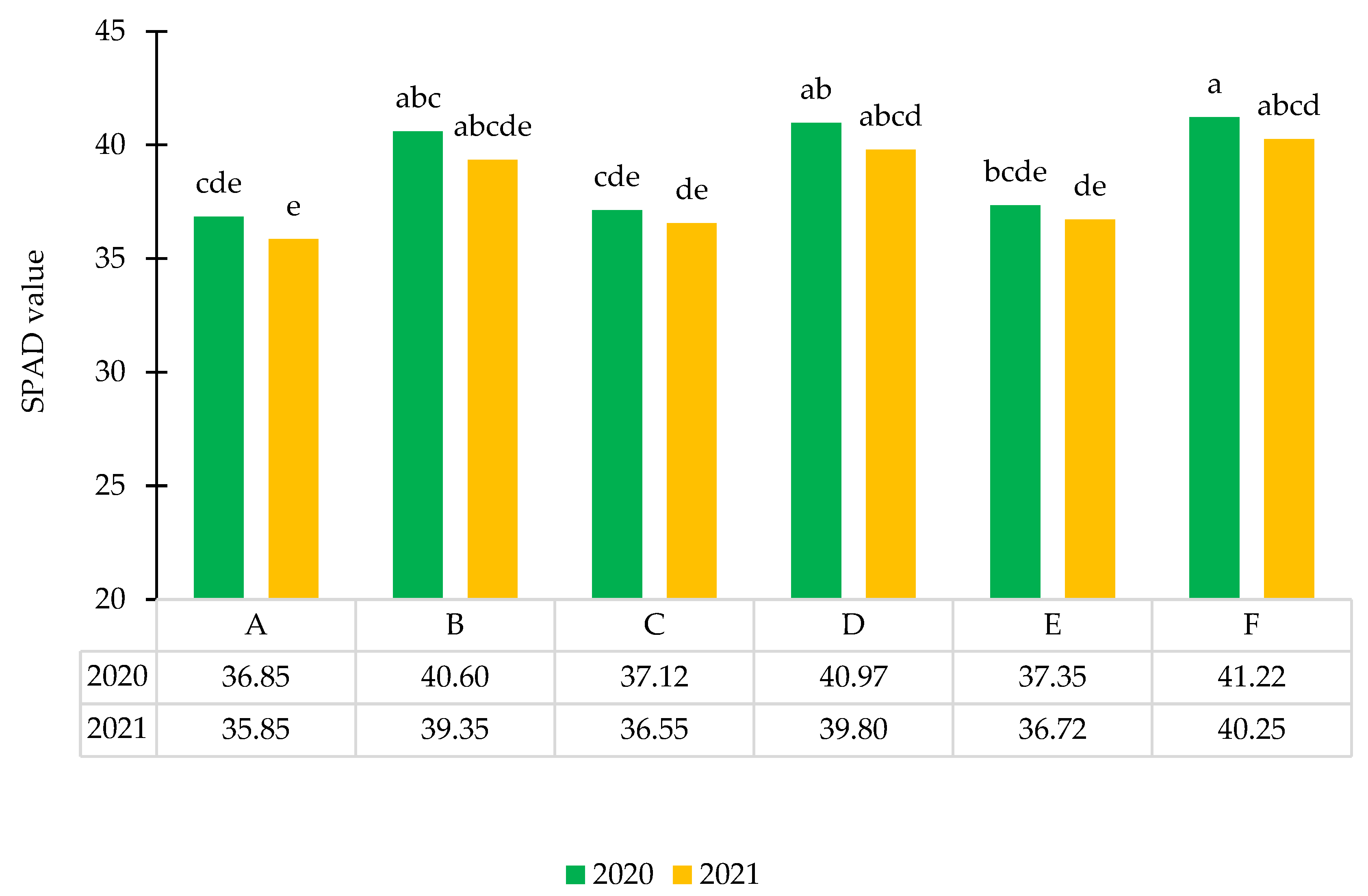
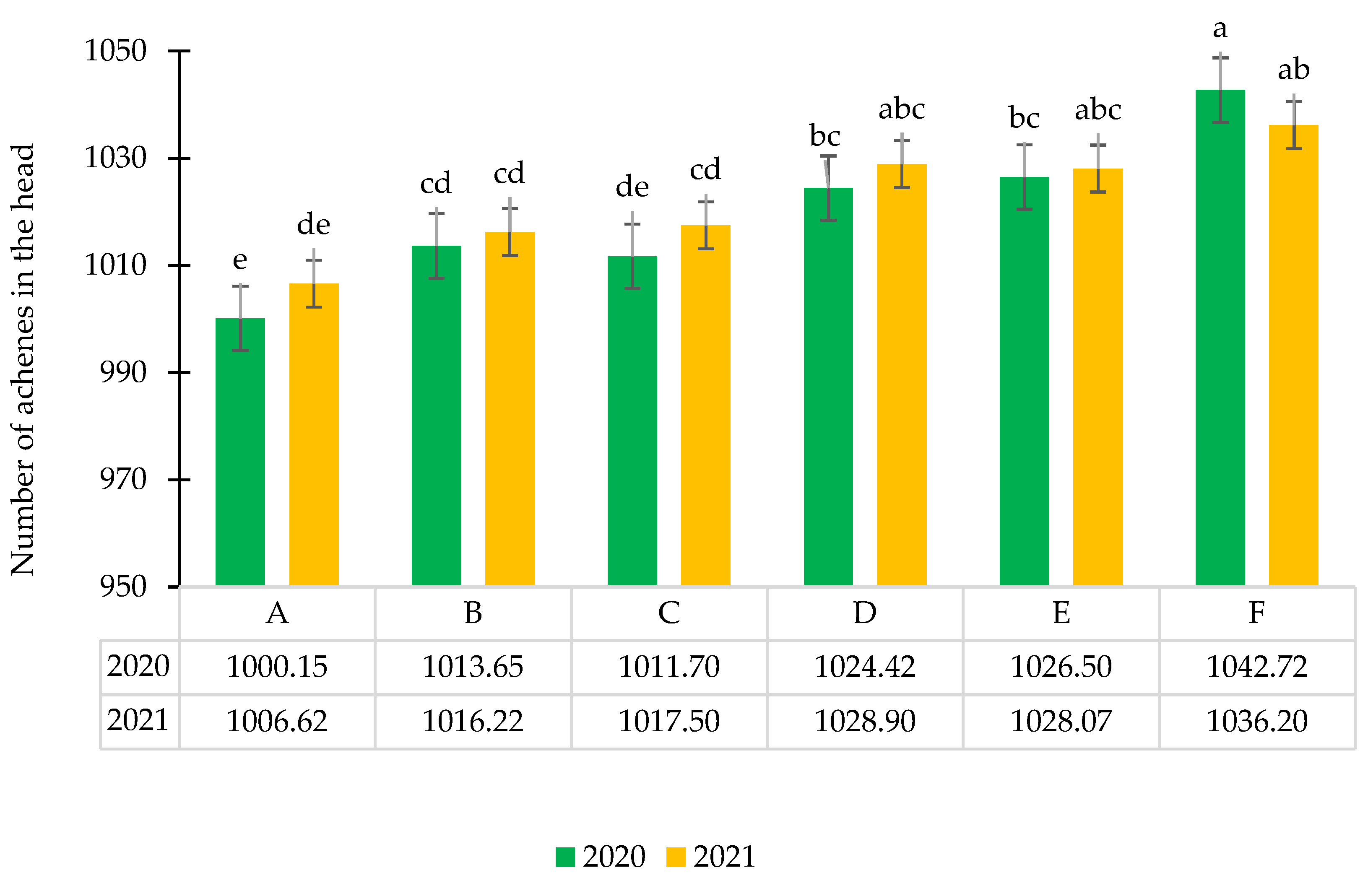
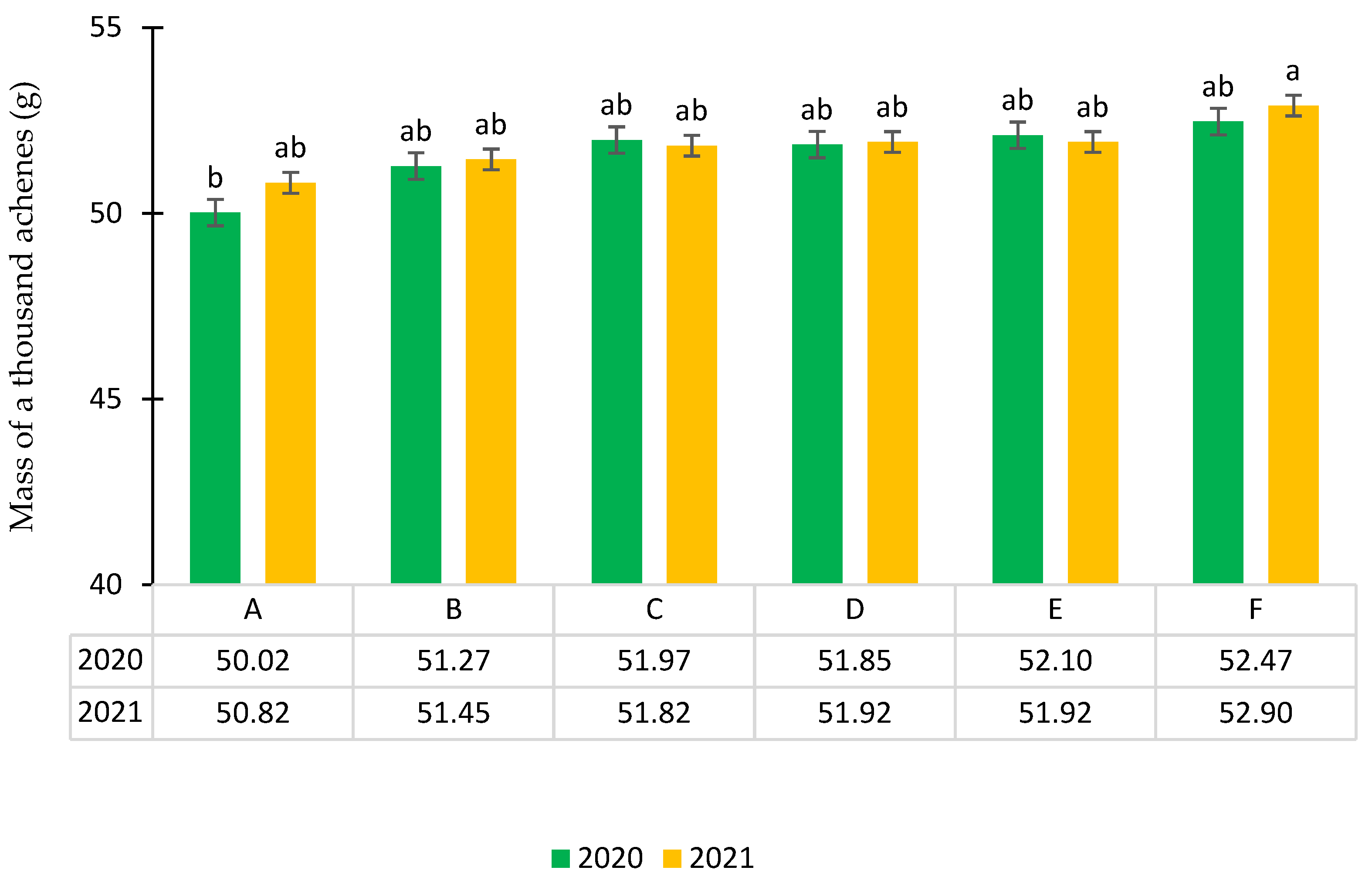
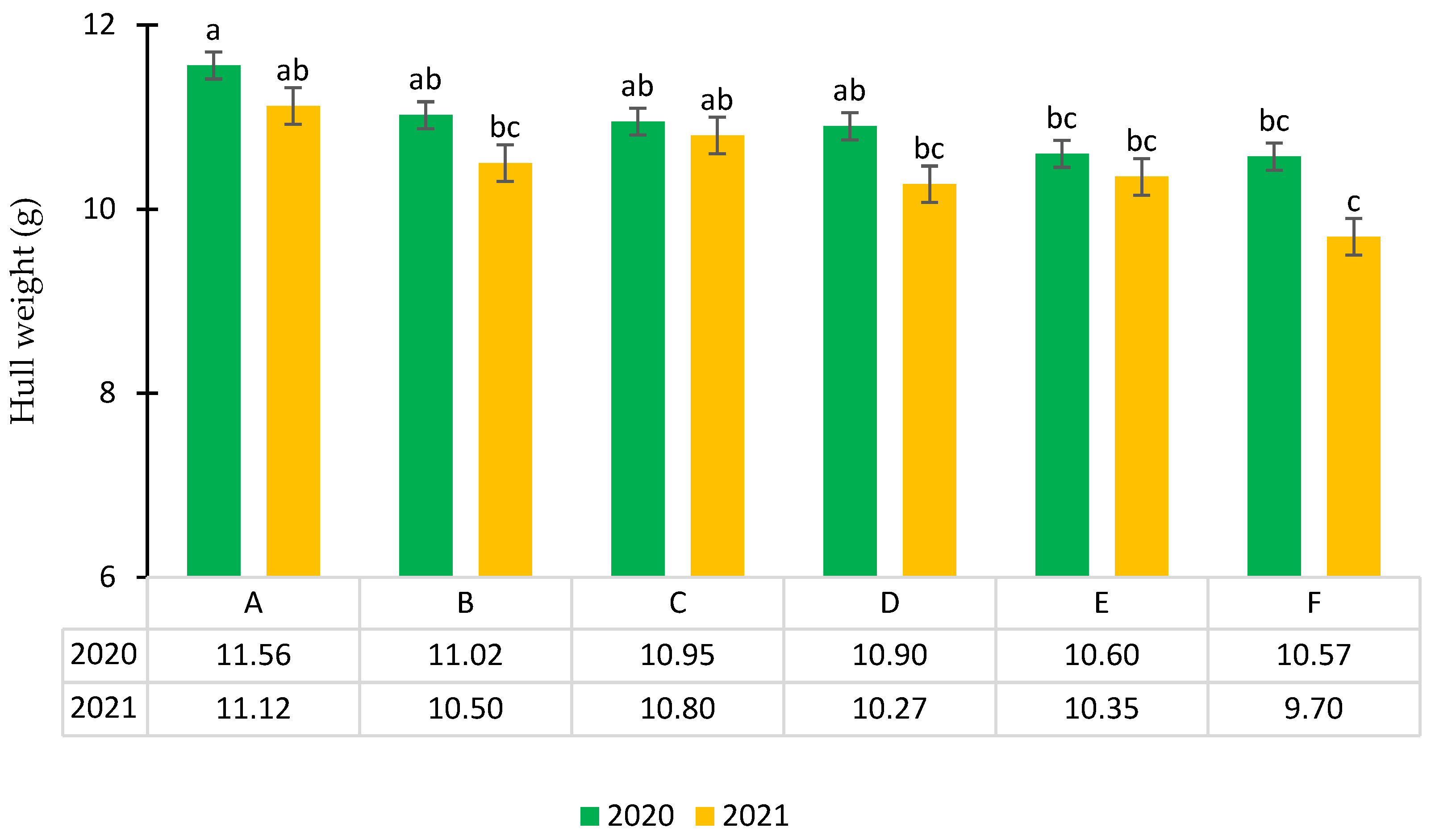
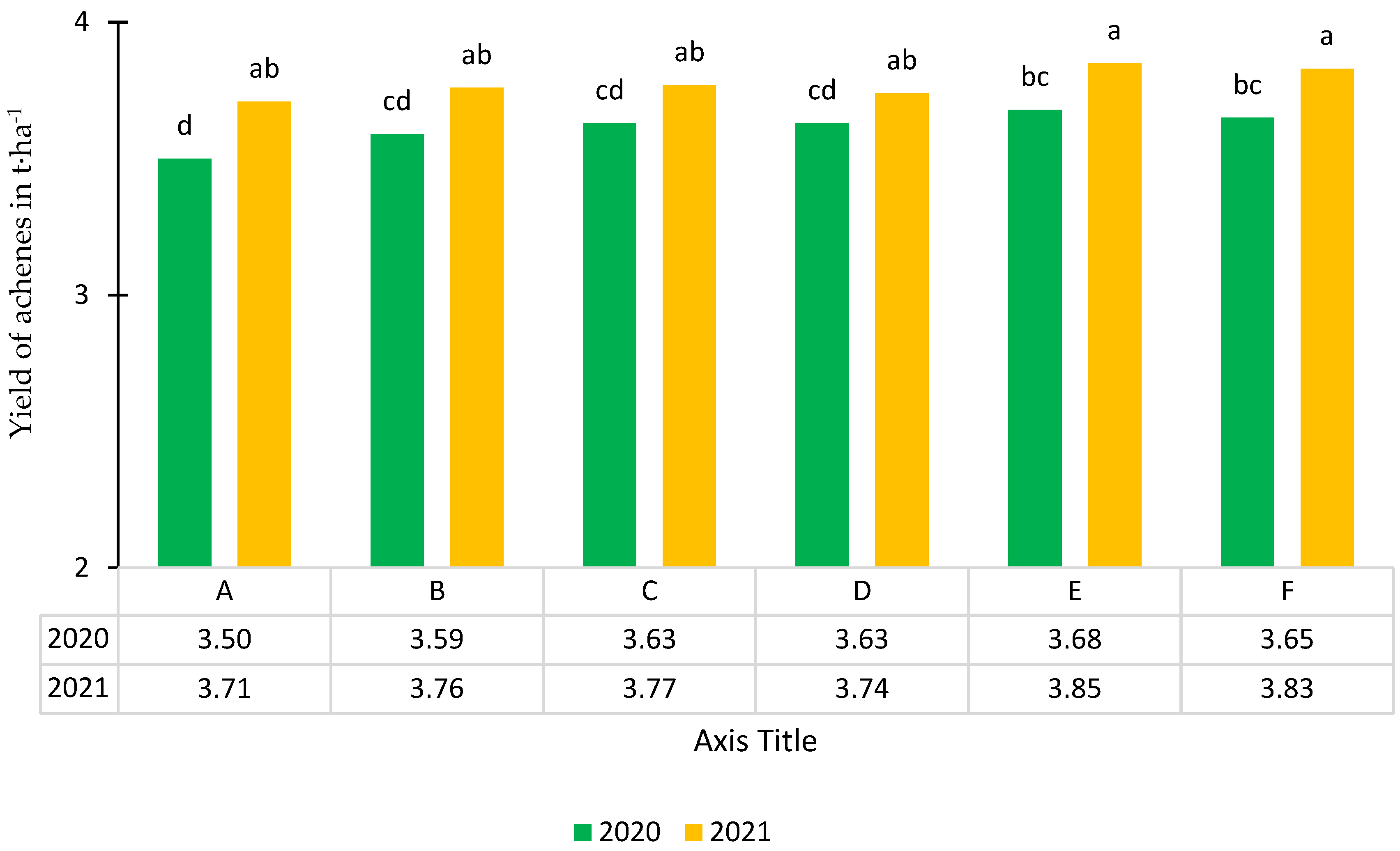
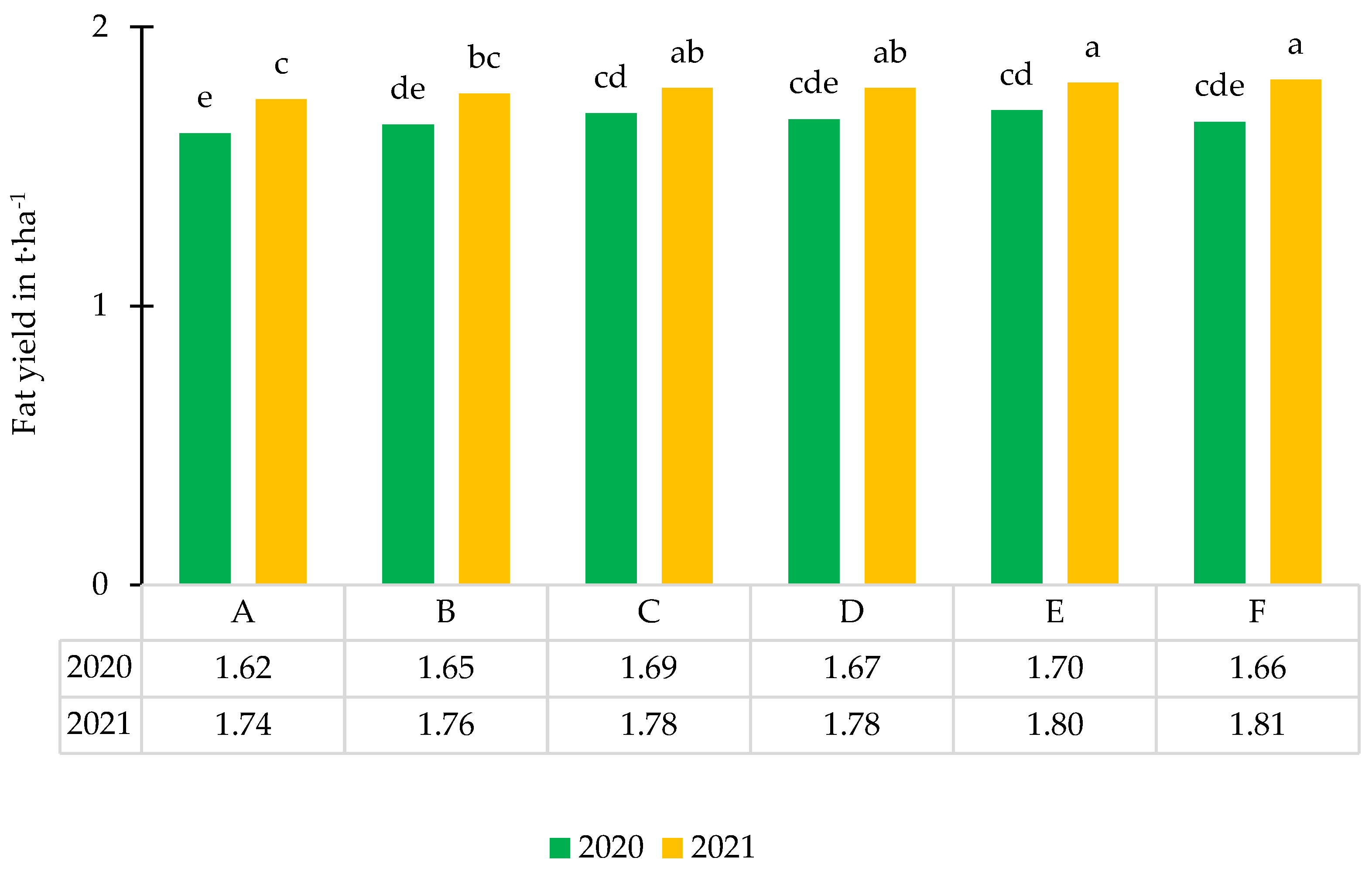
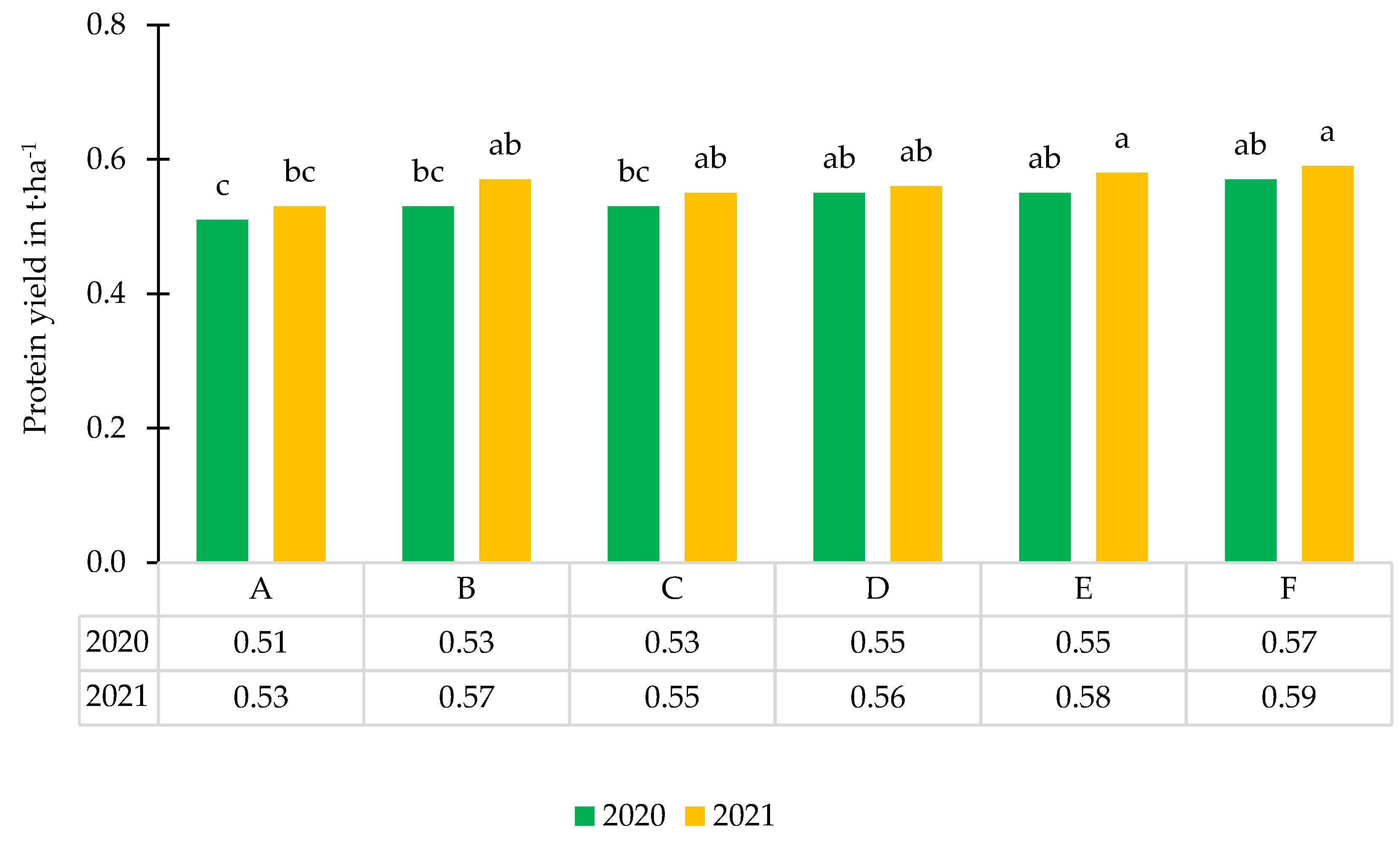
| Parameter | Unit | 2020 | 2021 |
|---|---|---|---|
| pH in KCl | - | 6.5 | 6.3 |
| Humus | % | 1.3 | 1.2 |
| Nmin | kg∙ha−1 | 56 | 52 |
| P2O5 | mg·100 g−1 gleby/soil | 18.4 | 17.5 |
| K2O | 21.2 | 22.4 | |
| Mg | 6.4 | 7.2 | |
| Fe | mg·1000 g−1 gleby/soil | 2352.6 | 2289.3 |
| Zn | 12.9 | 14.4 | |
| Mn | 251.3 | 389.6 | |
| Cu | 6.4 | 6.1 | |
| B | 1.5 | 1.7 |
| Preparation | Active Substance | Dose (L/ha) |
|---|---|---|
| Activus 400 S.C. (herbicide) | pendimetalina | 4.0 |
| Bandur 600 S.C. (herbicide) | aklonifen | 3.0 |
| Efica 960 EC (herbicide) | metolachlor-S | 1.25 |
| Amistar Gold Max (fungicide) | azoksystrobina, difenokonazol | 1.0 |
| Trico (repellant) | sheep fat | 15.0 |
| Month | Sum of Precipitation (mm) | Mean Temperature (°C) | ||||
|---|---|---|---|---|---|---|
| 2020 | 2021 | Multi-Years | 2020 | 2021 | Multi-Years | |
| III | 19.8 | 17.5 | 37.0 | 5.1 | 3.2 | 2.8 |
| IV | 10.0 | 49.4 | 46.0 | 9.2 | 6.5 | 8.7 |
| V | 83.3 | 63.9 | 77.1 | 11.3 | 12.8 | 13.7 |
| VI | 162.9 | 47.3 | 80.2 | 18.1 | 18.8 | 17.1 |
| VII | 18.9 | 55.0 | 95.4 | 18.8 | 21.6 | 19.0 |
| VIII | 7.3 | 107.4 | 65.0 | 19.9 | 17.5 | 18.4 |
| IX | 43.5 | 85.8 | 62.5 | 15.0 | 13.1 | 13.6 |
| X | 54.3 | 2.5 | 46.4 | 11.1 | 9.1 | 8.8 |
| Factor | Number of Plants before Harvest (pcs·m−2) | Head Diameter (cm) | LAI (m2/m2) |
|---|---|---|---|
| Fertilization | |||
| A | 6.99 ± 0.10 | 16.26 ± 0.79 b | 3.96 ± 0.17 b |
| B | 6.95 ± 0.07 | 16.76 ± 0.56 ab | 4.10 ± 0.19 a |
| C | 6.95 ± 0.09 | 16.95 ± 0.54 a | 3.98 ± 0.17 b |
| D | 7.00 ± 0.08 | 16.93 ± 0.56 a | 4.13 ± 0.19 a |
| E | 7.02 ± 0.06 | 17.01 ± 0.52 a | 3.99 ± 0.17 b |
| F | 7.01 ± 0.11 | 17.11 ± 0.55 a | 4.14 ± 0.19 a |
| Years | |||
| 2020 | 7.00 ± 0.09 | 17.00 ± 0.62 | 4.11 ± 0.19 a |
| 2021 | 6.98 ± 0.07 | 16.67 ± 0.60 | 4.00 ± 0.17 b |
| Factor | Fat | Protein | Ash | Fiber |
|---|---|---|---|---|
| Fertilization | ||||
| A | 46.61 ± 0.66 | 14.45 ± 0.56 d | 4.20 ± 0.16 | 15.04 a |
| B | 46.47 ± 0.81 | 15.02 ± 0.83 b | 4.28 ± 0.19 | 14.71 ab |
| C | 46.83 ± 1.03 | 14.70 ± 0.63 cd | 4.32 ± 0.16 | 14.85 ab |
| D | 46.72 ± 1.21 | 15.07 ± 0.81 b | 4.34 ± 0.12 | 14.44 ab |
| E | 46.43 ± 0.99 | 14.93 ± 0.66 bc | 4.35 ± 0.13 | 14.62 ab |
| F | 46.31 ± 1.32 | 15.40 ± 0.71 a | 4.36 ± 0.11 | 14.24 b |
| Years | ||||
| 2020 | 46.06 ± 0.76 b | 14.91 ± 0.66 | 4.29 ± 0.15 | 14.56 ± 0.35 |
| 2021 | 47.08 ± 0.94 a | 14.86 ± 0.78 | 4.33 ± 0.14 | 14.74 ± 0.38 |
| Fertilization | Mean Yield (t·ha−1) | Mean Yield (EUR·ha−1) | Fertilization Cost (EUR·ha−1) | Economic Result (EUR·ha−1) |
|---|---|---|---|---|
| A | 3.61 | 1976.01 | 133.80 | 1842.21 |
| B | 3.68 | 2014.32 | 200.70 | 1813.62 |
| C | 3.70 | 2025.27 | 151.63 | 1873.64 |
| D | 3.69 | 2019.80 | 218.53 | 1801.27 |
| E | 3.77 | 2063.58 | 169.46 | 1894.12 |
| F | 3.74 | 2047.16 | 236.36 | 1810.80 |
Publisher’s Note: MDPI stays neutral with regard to jurisdictional claims in published maps and institutional affiliations. |
© 2022 by the author. Licensee MDPI, Basel, Switzerland. This article is an open access article distributed under the terms and conditions of the Creative Commons Attribution (CC BY) license (https://creativecommons.org/licenses/by/4.0/).
Share and Cite
Jarecki, W. Effect of Varying Nitrogen and Micronutrient Fertilization on Yield Quantity and Quality of Sunflower (Helianthus annuus L.) Achenes. Agronomy 2022, 12, 2352. https://doi.org/10.3390/agronomy12102352
Jarecki W. Effect of Varying Nitrogen and Micronutrient Fertilization on Yield Quantity and Quality of Sunflower (Helianthus annuus L.) Achenes. Agronomy. 2022; 12(10):2352. https://doi.org/10.3390/agronomy12102352
Chicago/Turabian StyleJarecki, Wacław. 2022. "Effect of Varying Nitrogen and Micronutrient Fertilization on Yield Quantity and Quality of Sunflower (Helianthus annuus L.) Achenes" Agronomy 12, no. 10: 2352. https://doi.org/10.3390/agronomy12102352






